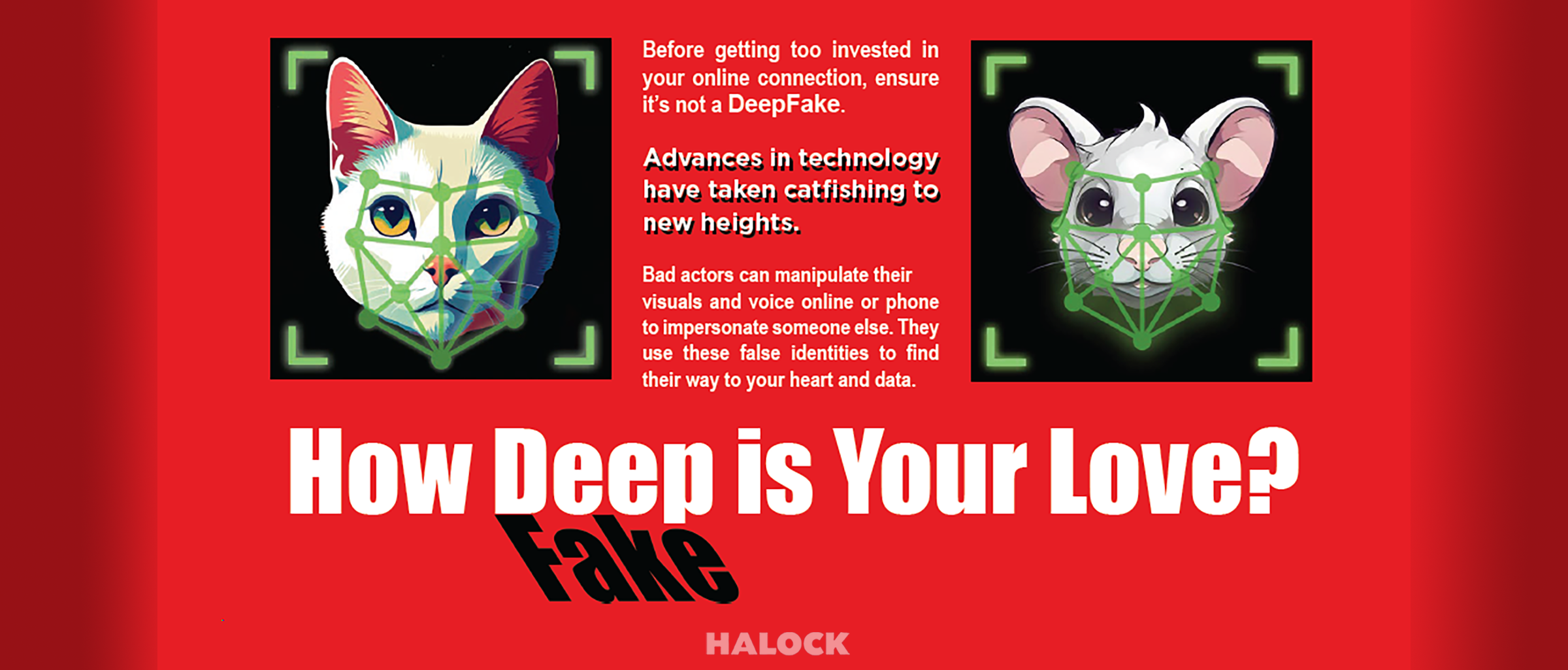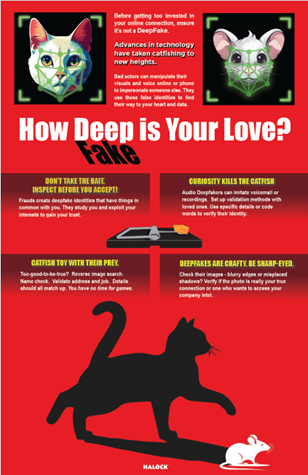Before getting too invested in your online connection, ensure it’s not a DeepFake. Advances in technology have taken catfishing to new heights. Bad actors can manipulate their visuals and voice online or phone to impersonate someone else. They use these false identities to find their way to your heart and data.
DEEPFAKES
The mere mention of this should throw you deep into thought. While the concept has only recently entered the public discourse, AI-generated DeepFakes have already led to an estimated $12 billion in fraud losses. Technology has gotten so advanced, individuals can now create convincing DeepFakes with an image, 60-seconds of audio, spending less than $15, and dedicating less than 10-minutes of effort.
What is a DeepFake?
Deepfakes are synthetic (but realistic) audio, video, and image content produced through artificial intelligence (AI) technologies, such as Generative Adversarial Networks (GANs) or other machine learning methods. AI can analyze images, videos, and voice recordings of specific people or generate entirely new identities. DeepFakes can replicate someone’s voice tone, intonation, mannerisms and other distinguishing traits, making it appear as though they are saying or doing things they never did. The term “DeepFake” combines “deep learning” with “fake,” highlighting both the technology behind it and its potential for deception. While there are legitimate uses for DeepFake technology, unfortunately, it can be easily misused for malicious purposes.
What can a DeepFake do?
Creators of DeepFakes can manipulate digital identities to say or do what they choose. There are legitimate applications, such as in the media and entertainment industry, where DeepFakes can be used to create action scenes safely or reduce the risk to actors. Unfortunately, the technology has also been nefariously used with detrimental effects. The risks are very real, as we have seen in recent headlines.
Malicious Uses of DeepFakes
BUSINESS
FINANCIAL FRAUD AND INTELLECTUAL PROPERTY THEFT
- Deepfake goal: Steal money from a large organization.
- How: Creating a Deepfake of an executive or C-suite member to access funds or confidential information. Most employees will quickly implement direct leadership requests without question, falling victim to such schemes.
- In the News: A finance professional attended a video conference with what appeared to be the company CFO and other colleagues. The DeepFake was so convincing that the employee transferred $25.6 million total (through numerous transactions) to the attackers.
- In the News: A Ferrari executive was targeted by a DeepFake impersonating Ferrari’s CEO, Benedetto Vigna. However, the clever executive thwarted the scam by asking a personal question Vigna would know the answer to.
CYBERSECURITY – PHISHING AND SOCIAL ENGINEERING
- Deepfake goal: Enhance the scale and effectiveness of cyber-attacks using DeepFake technology.
- How: An Audio DeepFake can impersonate a targeted employee and gain access to sensitive company data.
- In the News: A DeepFake voice convinced an IT support worker that he was also an employee at MGM, and needed to change his password. With the updated credentials, the attacker got access to the corporate networks.
FALSE INFORMATION
- Deepfake goal: Spread misinformation to damage reputations, sway public opinion, or disrupt political or military events.
- How: A Deepfake of a politician or leader announcing a drastic change in policy or a prominent figure appearing to behave inappropriately can cause significant turmoil and disruption.
- In the News: A DeepFake video with the likeness of Ukrainian President Volodymyr Zelenskyy was posted on social media telling his soldiers to surrender to Russia. It was discovered to be fake and removed.
- In the News: Deepfake content featuring the likeness of Philippine President Ferdinand Marcos Jr.asking for military action against China regarding the tensions in the South China Sea.
- In the News: In the 2024 Olympics, DeepFakes manipulated images, video, and audio to discredit coaches and athletes.
BRAND THEFT TO PROMOTE SCAMS
- Deepfake of famous and successful experts endorsing the scam as a legitimate answer to their problems.
- In the News: A DeepFake video of Elon Musk promoting an investment opportunity convinced people to open an account with their savings. It turned out to be hackers stealing money using Musk’s success and reputation to make their scam credible.
- In the News: A self-help course by Wesley Virgin was promoted by famous personalities Oprah Winfrey, Nigella Lawson, and Piers Morgan. These ads were all DeepFakes.
- In the News: A French doctor that appears on TV often has been trying to stop DeepFakes of his image being used to promote scam offers.
- In the News: Bad Actors use a DeepFake of Bob Irwin, son of the late and beloved Steve Irwin, ‘Crocodile Hunter’ to invest in a platform.
PERSONAL
HARMFUL IMPACTS ON INDIVIDUALS
- Loved Ones/Children: DeepFake technology has been used to create fake ransom calls, where a hacker impersonates a child or loved one (built off of available social content online) and demands money from friends or family. Many parents or loved ones will do anything to keep their loved ones and kids safe and pay the money – no questions asked.
- Reputation Damage: Bad actors use DeepFake technology to fabricate compromising images, video, or audio of their target, then extort money by threatening to release the content. The victim is usually too scared or embarrassed to tell anyone and desperately tries to get funds to pay off the blackmailer.
ROMANCE SCAMS – DEEP FEELINGS FOR DEEPFAKES
- Deepfake goal: DeepFakes to manipulate victims emotionally and financially through fabricated online relationships.
- How: Romance scams reach new levels with the dawning of DeepFakes. Malicious actors can develop the perfect online match for those seeking love. It is much easier to catfish or use a customized fake identity to build an online relationship. Scammers can make identities to fit specific age ranges, ethnicities, physiques, complete with desired accents. Whatever preference their targets want, DeepFakes can make.
- In the News: The Yahoo Boys use two devices to create a digital mask that the scammer uses over his own so the mannerisms on the false identity appear real. Plus, they establish plausibility to use video or audio to connect, as these fake personas are not local to their online partners – such as military personnel, offshore workers, transportation professionals such as pilots or just regular folks that live internationally. They can be an individual scam or a large syndicate to generate huge payouts.
- In the News: A Scottish woman lost over $30,000 to a DeepFake relationship with an oil rig worker.
- In the News: Hong Kong police caught a gang of scammers that catfished men across Asia to part with $46million.
HOW ARE DEEPFAKES CREATED?
There are many resources and tools available to create DeepFakes:
- FaceSwap enables users to swap faces in images as well as photos.
- DeepFaceLab is a popular tool for creating DeepFake videos.
- Avatarify is a real-time DeepFake tool that gives facial movements onto avatars during live video calls.
- Descript is an audio-focused AI tool used to creates realistic voice deepfakes using text-to-speech.
HOW CAN YOU DETECT DEEPFAKES?
The good news is that advances in technology bring solutions to help protect against these scams. Using AI and machine learning algorithms, DeepFakes can be identified by tools such as:
- Microsoft Video Authenticator – Analyzes pixels and metadata to check if content has been manipulated.
- Truepic – Uses digital fingerprinting to authenticate media of if it has been tampered with.
- Sensity AI – Detects DeepFakes in real-time.
SAFEGUARDING AGAINST DEEP TROUBLE
Protect yourself and your organization from the dangers posed by DeepFakes, consider implementing a combination of technology, awareness, and best practices and policies:
- Advanced detection tools and technologies.
- Strengthened verification protocols (MFA, live detection).
- Content provenance solutions (blockchain, watermarking).
- Employee training to recognize DeepFake-driven attacks.
- Collaboration and intelligence sharing to monitor emerging threats.
- Rapid Incident Response to minimize impact on the business and clients.
- Proactive PR management to minimize reputational damage.
Download your DeepFake Cybersecurity Awareness poster for your teams to remember to be alert and always verify your contacts and communications.


